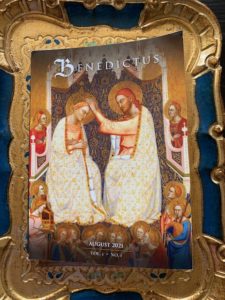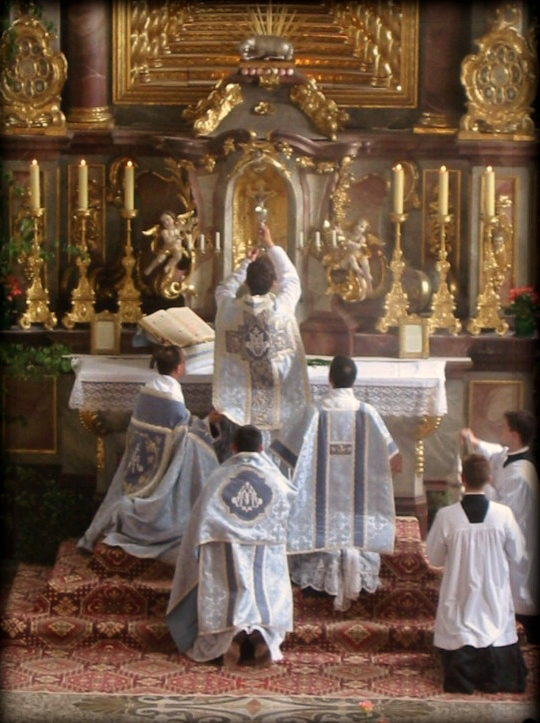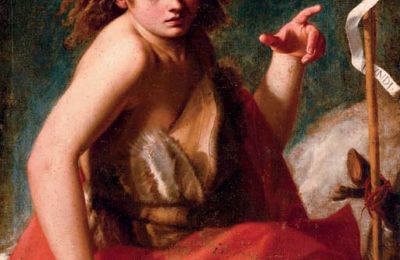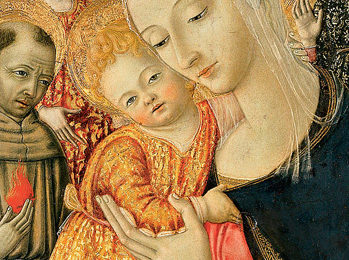
Beginning in August, there is a new monthly Catholic publication, Benedictus. This booklet, according to its stated aims (see below), should assist Catholics as they attend the Latin Mass, and support them as they live a traditional Catholic life. Benedictus is described by the publisher, Sophia Institute Press, as a Traditional Catholic Companion. The following “frequently asked questions” about Benedictus are taken from the publisher’s web site and will give you an idea of what the aims of the publication are (source at end):
What is Benedictus?
A pocket-size monthly booklet for anyone seeking to live a richly Catholic life, patterned on the traditional Roman Rite. Subscribers receive a new issue every month, chock-full of beautiful and edifying content in roughly 400 pages, including: daily morning and evening devotions from the traditional breviary, texts for the Latin Mass of the day, a brief meditation from a different Saint or classical author each day, several bonus sections of commentary and catechesis every month, pages of different prayers in English and Latin, as well as regular selections of Catholic poetry, chant, and beautiful sacred art. In sum, Benedictus is a simple, linear, daily companion resource for living in the heart of our Catholic Tradition. We call it “The Traditional Catholic Companion.”Why the Traditional Latin Mass?
In the words of Pope Benedict XVI:“What earlier generations held as sacred remains sacred and great for us too”(Summorum Pontificum).The steady, worldwide growth of interest in the ancient Roman Rite (particularly among young people) continues to reflect its perennial sanctity and life-giving vitality, as well as its mounting importance in increasingly secularized societies. Among the many monikers used to describe this liturgical form, Sophia most frequently chooses “Traditional Latin Mass/TLM” due to its near-universal recognizability. However, the terms Tridentine Mass, Usus Antiquior, Gregorian Rite, Vetus Ordo, Old Mass, Ancient Mass, and still others may also be used to describe this same liturgical heritage, common to all Roman Catholics.Who is this for?
Anyone interested in learning and living the Faith of our Fathers!CLERGY: this is a fantastic resource to share at church entrances, both for newcomers to the TLM and for veterans looking for ease-of-use and additional edifying content for daily prayer and meditation.
LAITY: its convenient size makes this an ideal devotional for each day, to keep at your bedside or dinner table, or to bring along to work or school.
TEACHERS: its monthly mini-essays, illustrations, and sections on art and culture will make excellent additions to your classroom toolbox.
PARENTS: this is a great resource for family catechesis, table readings before grace at meals, and for learning classic Catholic chants or poetry together.
CHILDREN: the beautiful art and typography can capture the little ones’ imaginations, while older children can use it to learn and follow along at Mass.
EVANGELISTS: it’s a perfect handout for non-Catholics interested in “how Catholics pray,” or for Catholics who are new to traditional worship. No ribbons or page-jumping required!
What does each issue include?
Daily Mass Texts following the 1962 Missale Romanum presented in a clear and simple format. Continuous Latin and English text with simplified rubrics for every Sunday of the month (no ribbons or page-jumping required). Complete Mass propers in English for all weekdays and major feasts.
Morning & Evening Devotions for each day are taken directly from the Divine Office, the Church’s ancient cycle of daily liturgical hours for clergy and religious. The morning selection is a Psalm and Canticle (with their antiphons) from the hour of Lauds, while the evening selection is a Psalm and Canticle (with their antiphons) from the hour of Vespers, both from the Breviarum Romanum.
Daily Meditations curated exclusively from Catholic Saints and scholars who prayed and loved the traditional form of the Roman Mass, ranging from the Early Church to the early 1900s. Selections are made to match the Church’s liturgical prayer of the day.
Informative Commentaries, such as mini-essays about the feasts and Saints of the traditional calendar, as well as brief catecheses and ideas for extending a liturgical life into the home.
Pages of Classic Prayers, with several offered in Latin and English, to assist in learning and praying in the mother tongue of the Church.
A Masterpiece of Sacred Art adorns the cover of every issue, and thematic works are selected to suit each month. Print subscribers also receive a separable holy card of the image with every issue, including a relevant monthly prayer on the reverse.
Extra Sections on Catholic Culture appear each month featuring selections of prose, poetry, or music that can help foster a thoroughly Catholic imagination.
Is this like MAGNIFICAT?
Yes, Benedictus has a daily read-through format that is similar to the Magnificat magazine. However, the content here is obviously different, given that Benedictus follows the traditional Mass and liturgical calendar, and features the writing of classical Saints and theologians rather than contemporary authors.Why is the traditional feast day calendar different?
The Roman liturgical calendar was extensively revised after the Second Vatican Council, to match the new order of Mass promulgated by Pope Paul VI in 1969. Just as the new Mass and liturgical calendar go hand in hand, and are often referred to as the “ordinary form,” the Traditional Latin Mass likewise follows the older liturgical calendar, and is often referred to as the “extraordinary form.” This is why so many days in the old calendar will feature one or more classic feasts that were either changed or removed in the new calendar.What Missal does this follow?
In accord with the provisions of Pope Benedict XVI’s Summorum Pontificum, Benedictus follows the 1962 edition of the Missale Romanum. With few exceptions, the English translations of the Latin text are from the celebrated Latin-English missal of Fr. Francis Xavier Lasance (The New Roman Missal, 1937).Is this good for newcomers to the Latin Mass?
Yes, it’s an ideal companion guide! Unlike other resources that newcomers may find intimidating and difficult to master, Benedictus has no page-jumps or placemark ribbons required to follow a complete Sunday Mass, in both Latin and English, from start to finish. There is no need to consult an Ordo to find the correct propers and commemorations of the day – all that is provided in straightforward, linear fashion. Simply find the current calendar date in the Table of Contents, turn to the Mass of that day, and read straight through.Additionally, once the reader understands the difference between the proper and ordinary parts of Mass (clearly marked in Benedictus), daily Masses also become easily navigable. See this unique and intuitive layout for yourself in the “look-inside” sample here.
Does this replace a “hand missal”?
As monuments to the Ancient Mass and Catholic piety, every Catholic household with sufficient means should own at least one heirloom-quality hand missal. That being said, Benedictus is designed as a monthly publication that features the content needed to pray with the Traditional Mass of each day plus additional content to nourish a fuller routine of daily prayer and formation – all drawn from the traditional Missal, Breviary, and writings of Catholic Saints and scholars of the past. This is something a single, standalone volume simply cannot do.Can this replace an altar missal?
No. The size and recurring nature of this publication precludes the inclusion of canonical rubrics and the ecclesiastical approbation necessary to make Benedictus anything more than a private devotional companion.What Bible is followed?
The Latin Scripture text is the Clementine Vulgate, the great translation of Saint Jerome as forever enshrined by the Ecumenical Council of Trent. The corresponding English text is the Challoner version of the Douay-Rheims Bible, the only approved English bible for over 300 years. Though perhaps not as easily readable as more modern English translations, Catholics can be confident of these versions’ freedom from moral or doctrinal error.Is the Divine Office included?
Excerpts from the Divine Office are included for every day of the week, but not the full Office. The Morning Devotion section contains one Psalm and one Canticle, both with their antiphons, taken from the hour of Lauds. The Evening Devotion section is likewise one Psalm and one Canticle, both with their antiphons, taken from the hour of Vespers. Both sections are in English only, and follow the Breviary and rubrics in force in 1960, as approved by Pope Benedict XVI in Summorum Pontificum.Who writes the essays?
Daily meditations are taken from numerous Saints, Doctors of the Church, and other approved Catholic authors, dating from the early Church up to the early 1900s. Writings are selected based on the liturgical theme of the day or month. As such, apart from some very limited editor’s comments, there are no contemporary authors featured in Benedictus.When is the first issue coming out?
The first complete month’s issue is slated for August 2021, fulfilling in July.Is there a subscription bonus?
For a limited time, subscribers will receive a free copy of Dr. Peter Kwasniewski’s brand new, highly acclaimed book on restoring Eucharistic reverence: The Holy Bread of Eternal Life.Are there bulk discounts?
Yes! We hope that parishes and chapels will order several copies to offer at church entrances, especially for those less familiar with the TLM. Boxes of 20 or more receive a 10% discount, and boxes of 100 or more receive a 15% discount.Is there a digital version?
A digital version of Benedictus is currently being developed. Please help us make this a reality by supporting our project through a subscription or donation!Is this available outside the USA?
Yes, international fulfillment will begin with the November issue, 2021.Who is behind Benedictus?
Sophia Institute Press has a specialized editorial team dedicated to this project, working in consultation with priests and theologians faithful to the Church’s Magisterium and familiar with the traditional Mass and Breviary.Can I advertise in Benedictus?
Catholic groups and causes, as well as other Catholic publishers, are welcome to apply for consideration by contacting Sophia Institute Press.Is Saint Joseph in the Canon?
Yes, per the provisions of Summorum Pontificum, which specify the 1962 Missal of Pope John XXIII as typical.Is the “Pre-1955” Holy Week included?
April of 2022 will be the first instance of Holy Week in Benedictus. We are currently considering several different options for how best to format this most sacred of weeks. If you have an opinion on this, we would love to hear from you through our website contact form.How do I contact Benedictus?
Visit our Contact page to get in touch with us. (source)
I hope that this publishing endeavor bears much fruit in Catholic lives all around the world.
May you have a good day, and I hope you are enjoying your summer.
~S.C. Fischer
*note: The Marian Room is not affiliated with Sophia Institute Press
~Top image: the Traditional Latin Mass, image from the the Priestly Fraternity of Saint Peter, available from http://fssp.org, image source
~Benedictus is the name of the canticle of Zachary from Luke 1: 68-79, see here






